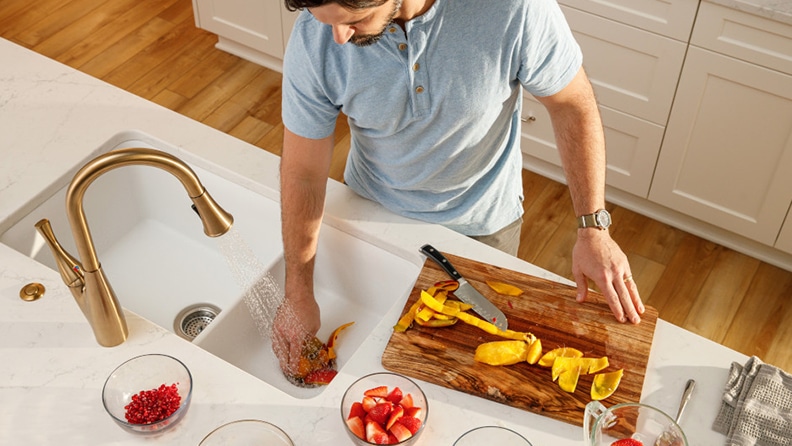Speedy Fixes for a Dripping Garbage Disposal
Speedy Fixes for a Dripping Garbage Disposal
Blog Article
In this article in the next paragraph you can discover a good deal of good points regarding Tips on Fixing a Leaking Garbage Disposal.

Garbage disposals are important kitchen area devices that help in getting rid of food waste effectively. Nonetheless, a leaking waste disposal unit can be an irritating and untidy problem to deal with. The good news is, lots of leaks can be repaired conveniently with a few straightforward actions. In this article, we will certainly discuss exactly how to repair a dripping waste disposal unit efficiently.
Intro
Garbage disposals are set up under cooking area sinks and are developed to shred food waste into smaller pieces, enabling it to travel through the pipes system quickly. While these gadgets are normally trusted, leakages can occur in time because of deterioration, loose links, or damages to the system.
Step-by-Step Guide to Taking Care Of a Leaking Waste Disposal Unit
Switch off the Power
Before attempting any type of repair services, guarantee that the power to the garbage disposal unit is switched off to stop the danger of electrical shock.
Situate the Leakage
Recognize the specific place of the leak and establish the cause
Tighten up Connections
Utilize a wrench to tighten any kind of loosened links in between the disposal unit and the plumbing system.
Change Seals or Gaskets
If the leak is due to worn seals or gaskets, get rid of the old elements and change them with brand-new ones.
Patching Cracks or Holes
For fractures or openings in the disposal device, usage epoxy or a suitable patching material to seal the damaged area.
Identifying the Source of the Leak
Before trying to fix a leaking garbage disposal, it is necessary to identify the source of the leakage. This can typically be done via aesthetic assessment or by conducting simple examinations.
Visual Assessment
Examine the waste disposal unit device very carefully for any indicators of water leakage. Pay close attention to areas around seals, gaskets, and link points.
Examining for Leaks
One method to test for leaks is by running water via the disposal system and looking for any noticeable signs of leakage.
Usual Sources Of Leaks in Garbage Disposals
Worn Seals and Gaskets
Seals and gaskets play an essential duty in stopping water from leaking out of the garbage disposal. Gradually, these elements can deteriorate, causing leakages around the disposal system.
Loose Links
The links in between the waste disposal unit and the pipes system can come to be loose gradually, triggering water to leak out during procedure.
Fractures or Holes in the Disposal Device
Physical damages to the garbage disposal, such as splits or openings in the housing, can additionally lead to leakages.
Tools and Products Needed for Taking Care Of a Leaking Waste Disposal Unit
Before starting the repair procedure, collect the required devices and materials, consisting of a screwdriver, adjustable wrench, plumbing professional's putty, replacement seals or gaskets, and epoxy or patching product for fixing cracks or holes.
Examining the Waste Disposal Unit After Repair Work
When the repair service is full, test the garbage disposal by running water through it to guarantee that the leak has been solved.
Preventive Upkeep Tips to Prevent Future Leaks
To avoid future leakages, it is vital to do regular maintenance on your waste disposal unit. This consists of maintaining it clean, avoiding placing non-food products or tough things down the disposal, and occasionally looking for leaks or other problems.
Verdict
Finally, fixing a dripping garbage disposal is a relatively straightforward procedure that can be completed with standard tools and products. By adhering to the actions described in this short article and exercising preventive maintenance, you can maintain your waste disposal unit in good working condition and prevent expensive repairs in the future.
HERE’S HOW TO FIX YOUR GARBAGE DISPOSAL
WHAT TO DO IF SOMETHING IS STUCK IN YOUR GARBAGE DISPOSAL
If the impeller won’t turn, there’s probably something stuck in the disposal. It could be a steak bone or peach pit, although plumbers report pulling all sorts of inappropriate objects out of disposals, such as bottle caps or aluminum foil. Make sure power to the disposal is off, and look inside to see if you can see the source of the jam.
Never stick your fingers in a disposal. Pull out anything you see with tongs or pliers.
If the disposal still won’t work, it may be time to call a plumber or consider buying a new disposal. GEM Plumbing & Heating is here for all of your garbage disposal needs.
WHAT TO DO IF YOUR GARBAGE DISPOSAL DRAIN IS CLOGGED
Take everything out from underneath your sink and put a bucket or other container under your disposal to catch any water that drains out. Disconnect your disposal from the power supply. If it’s plugged into a wall outlet, unplug it. If it’s hardwired into an electrical box, go to the electrical panel and turn off the breaker for the disposal. Pour ¼ cup of baking soda into the drain, followed by ½ cup of white vinegar. Give the solution a few minutes to fizz and do its work. Look into the disposal with a flashlight to see if you can see an object that might be causing the clog. If you see it, remove it using tongs or pliers. MORE TIPS ON DEALING WITH A CLOGGED GARBAGE DISPOSAL
Never use drain cleaner in a garbage disposal. It can damage the plastic parts inside the disposal. You can also be splashed with the caustic liquid while working to clear the clog. Beware! Never stick your fingers into a garbage disposal. Trust us — not a good idea. In many instances, your dishwasher drains through your garbage disposal. This allows the disposal to grind any large food particles that may be drained out of your dishwasher. There are some jurisdictions, however, where the plumbing code prohibits such a connection. WHAT TO DO WHEN YOUR DISHWASHER DRAINS THROUGH THE DISPOSAL
Run some water in the sink so your plunger has at least a ½-inch of water to create a seal and plunge vigorously up and down several times. You may need to repeat this several times. Run hot water down the drain to clear any residue that remains.

I ran across that content on Why Is when doing a search on the internet. Are you aware of another individual who is fascinated by the niche? Be sure share it. We cherish reading our article about Why Is .
Call Today Report this page